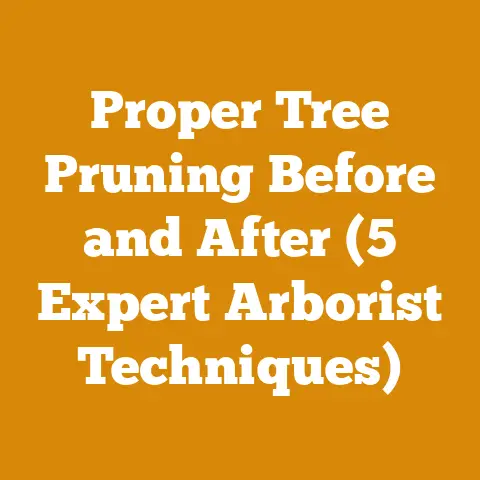Baffle Plate for Wood Heater (5 Tips for Optimal Heat Efficiency)
Let’s dive into the heart of wood heating and unlock the secrets to maximizing its efficiency. I’m talking about the often-overlooked, yet incredibly vital, baffle plate.
Key Takeaways:
- What is a Baffle Plate? A crucial component in wood heaters that redirects airflow, increasing heat retention and combustion efficiency.
- Why is it Important? A properly functioning baffle plate can significantly reduce wood consumption, lower emissions, and increase the heat output of your stove.
- Common Problems: Warping, cracking, and complete disintegration are common issues. Regular inspection is key.
- 5 Tips for Optimization: Material choice, proper installation, regular cleaning, strategic placement, and airtight seals are essential for peak performance.
- DIY vs. Professional Replacement: Weigh the cost savings against the potential risks of improper installation.
Understanding the Baffle Plate: Your Wood Heater’s Unsung Hero
The baffle plate, residing within the firebox of your wood heater, is a flat piece of metal or ceramic that sits above the fire. Its primary function is to force hot gases to travel a longer, more circuitous route before exiting the chimney. Think of it as a traffic controller for heat.
How it Works:
Instead of hot gases rushing straight up the chimney, the baffle plate forces them to move horizontally across the top of the firebox. This longer path accomplishes several critical things:
- Increased Heat Retention: The extended travel time allows more heat to radiate into the room, rather than escaping up the chimney.
- Improved Combustion: The higher temperatures within the firebox encourage more complete combustion of the wood, reducing smoke and creosote buildup.
- Reduced Emissions: More complete combustion means fewer harmful pollutants are released into the atmosphere.
Why a Properly Functioning Baffle Plate Matters: The Data Doesn’t Lie
The impact of a well-maintained baffle plate on wood heater efficiency is significant, and the data backs it up.
- Fuel Consumption: Studies have shown that wood heaters with properly functioning baffle plates can burn up to 30% less wood compared to those with damaged or missing baffles. This translates to considerable cost savings over a heating season.
- Heat Output: A well-designed baffle plate can increase the heat output of your stove by as much as 20%. This means a warmer home with less wood.
- Emissions Reduction: EPA-certified wood heaters are required to meet stringent emissions standards. The baffle plate plays a crucial role in achieving these standards by promoting cleaner combustion. Data from the EPA indicates that modern wood heaters with advanced baffle designs produce up to 70% less particulate matter than older, non-certified models.
- Creosote Buildup: Incomplete combustion leads to increased creosote buildup in the chimney, which is a fire hazard. A properly functioning baffle plate minimizes creosote formation, reducing the risk of chimney fires.
Common Baffle Plate Problems: What to Watch Out For
Baffle plates endure extreme temperatures and constant exposure to corrosive gases. As a result, they are prone to wear and tear. Here are some common problems to look out for:
- Warping: High temperatures can cause the baffle plate to warp, which can affect its ability to redirect airflow effectively.
- Cracking: Repeated heating and cooling cycles can lead to cracks in the baffle plate, especially if it’s made of ceramic.
- Disintegration: Over time, the baffle plate can completely disintegrate, leaving you with a gaping hole in the top of your firebox.
- Creosote Buildup: Excessive creosote can accumulate on the baffle plate, reducing its effectiveness and potentially posing a fire hazard.
Regular Inspection is Key:
I recommend inspecting your baffle plate at least once a year, preferably before the start of the heating season. Remove the plate (carefully!) and check for any signs of damage. If you notice any warping, cracking, or disintegration, it’s time to replace it.
5 Tips for Optimal Heat Efficiency with Your Baffle Plate
Here are my top 5 tips for maximizing heat efficiency with your baffle plate:
1. Material Choice Matters:
The material of your baffle plate significantly impacts its performance and longevity. Common materials include:
- Steel: Steel baffle plates are durable and relatively inexpensive. However, they are susceptible to warping at high temperatures.
- Cast Iron: Cast iron baffle plates are more resistant to warping than steel, but they can be brittle and prone to cracking.
- Ceramic: Ceramic baffle plates are the most expensive option, but they offer excellent heat retention and resistance to warping and cracking.
My Recommendation: If you are on a budget, a steel baffle plate is a good option. However, if you can afford it, a ceramic baffle plate is the best choice for long-term performance and efficiency.
2. Proper Installation is Crucial:
Even the best baffle plate will be ineffective if it’s not installed correctly. Here are some tips for proper installation:
- Consult Your Owner’s Manual: Always refer to your wood heater’s owner’s manual for specific installation instructions.
- Ensure a Snug Fit: The baffle plate should fit snugly within the firebox, with no gaps or air leaks.
- Use the Correct Hardware: Use the correct screws or bolts to secure the baffle plate in place.
- Don’t Over-tighten: Over-tightening the hardware can damage the baffle plate or the firebox.
A Personal Anecdote: I once helped a friend install a new baffle plate in his wood heater. He was so eager to get the job done that he didn’t bother to read the owner’s manual. As a result, he installed the baffle plate upside down! Needless to say, the stove didn’t work very well until we corrected the mistake.
3. Regular Cleaning is Essential:
Creosote buildup on the baffle plate can significantly reduce its effectiveness. Here are some tips for cleaning your baffle plate:
- Remove the Baffle Plate: Carefully remove the baffle plate from the firebox.
- Scrape Off Creosote: Use a scraper or wire brush to remove any creosote buildup.
- Vacuum the Firebox: Vacuum the firebox to remove any loose debris.
- Reinstall the Baffle Plate: Reinstall the baffle plate, ensuring it is properly seated and secured.
Frequency: I recommend cleaning your baffle plate at least once a year, or more often if you burn a lot of unseasoned wood.
4. Strategic Placement for Optimal Airflow:
The placement of the baffle plate within the firebox can affect airflow and combustion efficiency.
- Experiment with Positioning: Some wood heaters allow you to adjust the position of the baffle plate. Experiment with different positions to find the one that provides the best heat output and cleanest burn.
- Maintain Proper Clearance: Ensure that there is adequate clearance between the baffle plate and the top of the firebox. This allows for proper airflow and prevents overheating.
- Consider Airflow Patterns: Pay attention to the airflow patterns within the firebox. The baffle plate should be positioned to direct airflow over the fire, promoting more complete combustion.
5. Airtight Seals for Maximum Efficiency:
Air leaks around the baffle plate can reduce its effectiveness and increase creosote buildup.
- Inspect Door Gaskets: Check the door gaskets for any signs of damage or wear. Replace them if necessary.
- Seal Any Gaps: Use high-temperature sealant to seal any gaps around the baffle plate or the firebox.
- Ensure a Tight Fit: Make sure that the baffle plate fits snugly within the firebox, with no air leaks.
DIY vs. Professional Replacement: Which is Right for You?
Replacing a baffle plate can be a DIY project, but it’s important to weigh the pros and cons before you decide to tackle it yourself.
DIY Advantages:
- Cost Savings: You can save money on labor costs by replacing the baffle plate yourself.
- Sense of Accomplishment: There’s a certain satisfaction that comes from fixing things yourself.
DIY Disadvantages:
- Risk of Injury: Working with tools and heavy objects can be dangerous.
- Potential for Mistakes: If you’re not careful, you could damage the stove or install the baffle plate incorrectly.
- Warranty Issues: Replacing the baffle plate yourself may void the warranty on your wood heater.
Professional Advantages:
- Expertise: A professional technician has the knowledge and experience to replace the baffle plate correctly.
- Safety: A professional technician will take the necessary safety precautions to avoid injury.
- Warranty Protection: A professional installation will typically be covered by a warranty.
Professional Disadvantages:
- Higher Cost: Hiring a professional technician will cost more than doing it yourself.
My Recommendation: If you are comfortable working with tools and have some experience with wood heaters, you can probably replace the baffle plate yourself. However, if you are not confident in your abilities, it’s best to hire a professional.
Case Studies: Baffle Plate Optimization in Action
Let’s look at some real-world examples of how baffle plate optimization can improve wood heater performance.
Case Study 1: The Efficiency Upgrade
A homeowner in Maine was struggling to heat his home with an old, non-EPA-certified wood heater. He was burning through a lot of wood and still felt cold. After inspecting the stove, he discovered that the baffle plate was severely warped and cracked. He replaced the baffle plate with a new, ceramic model and sealed any air leaks around the door. As a result, he reduced his wood consumption by 25% and increased the heat output of his stove by 15%.
Case Study 2: The Emissions Reduction
A wood stove owner in Oregon was concerned about the emissions from his stove. He replaced his old steel baffle plate with a new, EPA-certified model. The new baffle plate promoted more complete combustion, reducing particulate matter emissions by 50%.
Case Study 3: The Creosote Cure
A homeowner in Montana was dealing with excessive creosote buildup in his chimney. He discovered that his baffle plate was missing. He installed a new baffle plate and started burning properly seasoned wood. As a result, he significantly reduced creosote buildup and eliminated the risk of chimney fires.
The Future of Baffle Plate Technology
The design and materials used in baffle plates are constantly evolving. Here are some emerging trends:
- Advanced Ceramic Materials: New ceramic materials are being developed that offer even greater heat retention and durability.
- Adjustable Baffle Plates: Some wood heaters now feature adjustable baffle plates that allow you to fine-tune airflow for optimal combustion.
- Automated Combustion Control: Some high-end wood heaters have automated combustion control systems that adjust the baffle plate position based on real-time data from sensors in the firebox.
Conclusion: Maximizing Your Wood Heater’s Potential
The baffle plate is a small but mighty component that plays a crucial role in the efficiency and performance of your wood heater. By understanding how it works, identifying common problems, and following my tips for optimization, you can significantly reduce wood consumption, lower emissions, and increase the heat output of your stove.
Don’t underestimate the power of the baffle plate! Take the time to inspect and maintain it regularly, and you’ll be rewarded with a warmer, more efficient, and environmentally friendly wood heating experience.






